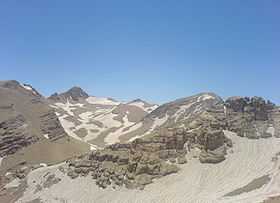Zard-Kuh
From Wikipedia, the free encyclopedia
"Zard Kuh" redirects here. For the village in Iran, see Zard Kuhi.
| Zard Kuh | |
|---|---|
 | |
| Elevation | 4,200 m (13,780 ft)[1] |
| Prominence | 2,095 m (6,873 ft)[1] |
| Listing | Ultra |
| Translation | Yellow Mountain (Persian) |
| Location | |
 Zard Kuh | |
| Range | Zagros Mountains |
| Coordinates | 32°21′52″N 50°4′39″E / 32.36444°N 50.07750°ECoordinates: 32°21′52″N 50°4′39″E / 32.36444°N 50.07750°E |
Zard Kuh (meaning "Yellow Mountain", also spelled Zardkuh or Zard-e Kuh-e Bakhtiari; Persian: زردكوه بختياري) is a mountain in the central Zagros Range, Iran.
It is located in the Zagros Mountains in the Chaharmahal and Bakhtiari Province of Iran. The Karun and also Zayanderud rivers start in the Zagros mountains near the Zardkuh. There are small glaciers on the mountain owing to the relatively high precipitation, which are the only glaciers in the subtropics outside the Himalayas and Andes[2]
Famous documentary Grass: A Nation's Battle for Life (1925) captures on film the Bakhtiari tribe's amazing crossing of Zard Kuh barefoot in the snow with 50,000 people and 500,000 animals.
See also
References
- ↑ 1.0 1.1 "Iran: 54 Mountain Summits with Prominence of 1,500 meters or greater" Peaklist.org. Sources differ significantly on the elevation of this peak. Peakbagger for example gives an elevation of 4,548 m and a prominence of 2,443 m. Retrieved 2012-04-29.
- ↑ Glaciers of Iran
External links
This article is issued from Wikipedia. The text is available under the Creative Commons Attribution/Share Alike; additional terms may apply for the media files.